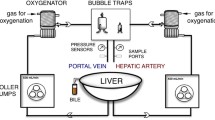Abstract
Arterial blood ketone body ratio (acetoacetate/3-hydroxybutyrate; KBR), which reflects hepatic mitochondrial redox potential, was measured during a 2-week period after orthotopic liver transplantation in three groups of rats: group 1, the isogenic combination of LEW (RT11) graft to LEW recipient as control; group 2, the allogenic combination of ACI (RT1a) graft to LEW recipient without immunosuppressive treatment; and group 3, the allogenic combination of ACI to LEW with immunosuppressive treatment using cyclosporin (CyA). Isogenic recipients survived indefinitely. Allogenic recipients in group 2 had severe rejection with a mean survival of 10.3±0.54 days, while 77.8% of the allogenic recipients in group 3 survived more than 30 days. KBR of rats surviving more than 2 weeks in groups 1 and 3 gradually increased post-transplantation and was maintained at a high level. By contrast, though KBR in group 2 was restored at 3 days, it gradually fell and remained at a significantly low level (P<0.001). It is suggested that KBR provides an accurate indicator for evaluating metabolic viability of the critically deteriorating liver graft accompanied by severe rejection.
Similar content being viewed by others
References
Chapmann MJ, Miller LR, Ontro JA (1973) Localization of the enzymes of ketogenesis in rat liver mitochondria. J Cell Biol 58: 284–306
Fath JJ, Ascher NL, Konstantinides FN, Bloomer J, Sharp H, Najarian JS, Cerra FB (1984) Metabolism during hepatic transplantation. Surgery 96: 664–674
Gubernatis G, Bornscheuer A, Taki Y, Farle M, Lubbe N, Yamaoka Y, Beneking M, Burdelski M, Oellerich M, Pichlmayr R (1989) Total oxygen consumption, ketone body ratio and a special score are early indicators of irreversible liver allograft non-function. Transplant Proc 21: 2279–2281
Harano Y, Kosugi K, Hyosu T, Uno S, Ichikawa Y, Shigeta Y (1983) Sensitive and simplified method for the differential determination of serum levels of ketone bodies. Clin Chim Acta 134: 327–332
Kamada N, Calne RY (1983) A surgical experience with five hundred thirty liver transplants in the rat. Surgery 93: 64–69
Kamiike W, Burdelski M, Steinhoff G, Ringe B, Lauchart W, Pichlmayr R (1988) Adenine nucleotide metabolism and its relation to organ viability in human liver transplantation. Transplantation 45: 138–143
Lehninger AL, Sudduth HC, Wise JB (1960) D-3-Hydroxybutyrate dehydrogenase of mitochondria. J Biol Chem 235: 2450–2455
Mellanby J, Williamson DH (1974) Acetoacetate. In: Bergmeyer HU (ed) Methods of enzymatic analysis. Academic Press, New York, pp 1446–1451
Ozawa K (1983) Biological significance of mitochondrial redox potential in shock and multiple organ failure: redox theory. In: Lefer AM, Schumer W (eds) Molecular and cellular aspects of shock and trauma. Liss, New York, pp 39–66
Ozawa K, Fujimoto T, Nakatani T, Asano M, Aoyama H, Tobe T (1982) Changes in hepatic energy charge, blood ketone body ratio, and indocyanine green clearance in relation to DNA synthesis after hepatectomy. Life Sci 31: 647–653
Ozawa K, Aoyama H, Yasuda K, Shimahara Y, Nakatani T, Tanaka J, Yamamoto M, Kamiyama Y, Tobe T (1983) Metabolic abnormalities associated with postoperative organ failure: a redox theory. Arch Surg 118: 1245–1251
Ozawa K, Kamiyama Y, Kimura K, Yamamoto M, Aoyama H, Yasuda K, Tobe T (1983) Contribution of the arterial blood ketone body ratio to elevate plasma amino acids in hepatic encephalopathy of surgical patients. Am J Surg 146: 299–305
Reilly JJ Jr, Halow GM, Gerhardt AL, Ritter PS, Gaveler JS, Thiel DH van (1985) Plasma amino acids in liver transplantation: correlation with clinical outcome. Surgery 97: 263–269
Shaw BW Jr, Gordon RD, Iwatsuki S, Starzl TE (1985) Hepatic retransplantation. Transplant Proc 17: 264–271
Taki Y, Ukikusa M, Morimoto T, Yokoo N, Koizumi K, Noguchi M, Tanaka A, Yamamoto S, Nitta N, Kamiyama Y, Shimahara Y, Yamaoka Y, Ozawa K (1987) Short-term changes in blood ketone body ratio in the phase immediately after liver transplantation. Transplantation 43: 350–354
Tanaka A, Noguchi M, Morimoto T, Taki Y, Shimahara T, Nakatani T, Tanaka K, Kamiyama Y, Yamaoka Y, Ozawa K (1987) Influence of hemodilution on hepatic energy metabolism in rats. Eur Surg Res 19: 200–206
Tanaka J, Ozawa K, Tobe T (1979) Significance of blood ketone body ratio as an indicator of hepatic cellular energy status in jaundiced rabbits. Gastroenterology 76: 691–700
Tokunaga Y, Ozaki N, Wakashiro S, Ikai I, Morimoto T, Shimahara Y, Kamiyama Y, Yamaoka Y, Ozawa K, Nakase Y (1987) Fluorometric study for the noninvasive deterioration of cellular viability in perfused rat livers. Transplantation 44: 701–706
White A, Handler P, Smith E (1978) Principles of biochemistry. McGraw-Hill Kogakusha, Tokyo
Williamson DH, Mellanby J (1974) D-(−)-3-hydroxybutyrate. In: Bergmeyer HU (ed) Methods of enzymatic analysis. Academic Press, New York, pp 1836–1839
Williamson DH, Lund P, Krebs HA (1967) The redox state of free nicotinamide adenine dinucleotide in the cytoplasma and mitochondria of rat livers. Biochem J 103: 514–526
Yamamoto M, Tanaka J, Ozawa K, Tobe T (1980) Significance of acetoacetate/3-hydroxybutyrate ratio in arterial blood as an indicator of the severity of hemorrhagic shock. J Surg Res 28: 124–131
Author information
Authors and Affiliations
About this article
Cite this article
Asonuma, K., Tanaka, K., Uemoto, S. et al. Changes in blood ketone body ratio with reference to graft viability after liver transplantation in rats. Transplant Int 2, 133–136 (1989). https://doi.org/10.1007/BF02414599
Issue Date:
DOI: https://doi.org/10.1007/BF02414599




